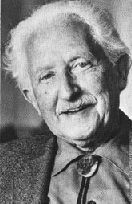Erik Erikson
On June 15th
1902, Frankfurt Germany was blessed because Erik Erikson was born. There is
no doubt about who Erikson’s mother is, her name was Karla Abrahamsen. Karla
was Jewish and she is responsible for the rearing of Erikson for his first
three years of his life. The father of Erikson had unfortunately abandoned
Karla and he is merely described as a Danish man with no name to identify
him with. What we sometimes forget is that Erik Erikson was originally born
Erik Homburger. Karla married a Jewish M.D. named Theodor Homburger who was
Erik’s pediatrician. Erik Homburger was his name during his childhood and
early adulthood as well, and instead of revealing the truth about his birth,
his mother and step-father decided to keep the details a secret. Therefore,
even up to this day there is an unsolved mystery about Erikson’s heritage.
With this in mind, it is said that Erikson had faced his own identity crisis
at a very young age. Erikson was not a hundred percent Jewish and his
physical appearance was something that he struggled with. He was not an
unattractive person, but he did however appear to be Nordic and this was a
problem for him when he attempted to fit either culture. Blond, blue-eyed,
and tall are not exactly the characteristics of your typical Jewish boy and
that is exactly what he looked like. Sadly, Erikson was teased accordingly
depending where he was at. Erikson was teased for appearing Nordic when he
was in Temple school and when he was in grammar school he was teased for
being Jewish. The development of one’s own identity is an important building
block of Erikson’s theory, but one must take into account is that it was
also an important factor of Erikson’s own life and it was indeed one of his
greatest concerns.
Erikson was
advised by his family to pursue a career in medicine, but that was just
something that did not interest him at that particular time. He was just not
interested in the atmosphere that proper schooling produced. He was much
more interested in pursuing a career as an artist, so instead of attending
college he spent about a year traveling all over Europe just keeping a
journal of his personal experiences. Once he got over this phase, he
returned back to Germany and actually graduated from art school and was then
offered a position in Vienna in a private school. He taught art as well as
other subjects as well, but mostly to the children of the American families
that were in Vienna. Apparently several Americans flew in for the purpose of
experiencing the Freudian training. In the late 1920s he was an established
art teacher, but he did not stop there. He applied and was accepted to the
Vienna Psychoanalytic Institute where he then met someone by the name of
Anna Freud. Anna was an Austrian psychoanalyst and she is responsible for
encouraging Erikson to study child psychoanalysis. Anna is also the daughter
of a particularly skilled psychologist of the time named Sigmund Freud. At
the same time he came across a Canadian dance teacher by the name of Joan
Serson. Joan was also an important person in Erikson’s life because he
married her and had three children with her. Then in 1933, he left Vienna
with his family and came to the United States. It was not until 1939, when
he became an American Citizen that he decided to change his last name from
Homburger to Erikson. He then became Boston’s first child analyst and
obtained a position in several well recognized institutions such as Harvard
Medical School, Yale University, Berkeley, and the Menninger Foundation. In
1950, he wrote first book titled Childhood and Society. That same
year, a Senator by the name of Joseph McCarthy investigated Erikson for
suspected communist influence. He was at Berkeley at the time and when he
was asked to sign a loyalty oath he decided to leave that institution. Other
books that he wrote include Young Man Luther (1958), Insight and
Responsibility (1964), and Identity: Youth and Crisis (1968).
Despite all of the changes in the location of his teaching, Erikson did
however return to Harvard University. He was a professor in Human
Development and he stayed there until he retired in 1970.



